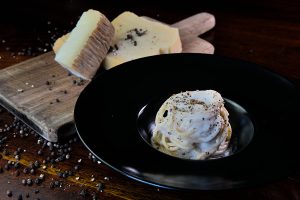A group of Italian scientists found what makes cacio e pepe fail and how to reliably make it succeed.
From the Journal: Physics of Fluids

WASHINGTON, April 29, 2025 – The beloved Italian pasta cacio e pepe is perhaps best known for two things: being delicious and being frustratingly difficult to cook. At first glance, it looks like a simple recipe, containing only three ingredients: pasta, pecorino romano cheese, and black pepper. But as anyone who has tried to make it will know, the cheese will often clump when added to the hot pasta water, turning what is supposed to be a smooth, creamy sauce into a stringy, sticky mess.
In Physics of Fluids, by AIP Publishing, researchers from the University of Barcelona, the Max Planck Institute for the Physics of Complex Systems, the University of Padova, and the Institute of Science and Technology Austria studied the physics of mixing cheese in water. They determined the mechanism that causes the cheese sauce to go from creamy to clumpy and developed a foolproof recipe for cacio e pepe based on their findings.
For these researchers, their work was about more than idle curiosity.
“We are Italians living abroad,” said author Ivan Di Terlizzi. “We often have dinner together and enjoy traditional cooking. Among the dishes we have cooked was cacio e pepe, and we thought this might be an interesting physical system to study and describe. And of course, there was the practical aim to avoid wasting good pecorino.”
The team first focused on the starch in the pasta water as the key ingredient for a perfect sauce. Typically, fatty substances like cheese cannot mix with water, but a stabilizer like starch helps to bridge that gap. In their tests, the researchers found that a 2%-3% starch-to-cheese ratio produced the smoothest, most uniform sauce.
The other key element of a perfect cacio e pepe sauce is heat — or rather, a lack of it. Too much heat denatures the proteins inside the cheese, causing them to stick together and leading to the dreaded clumps. Instead, the authors advise letting the water cool before mixing in the cheese and bringing the sauce up to temperature as slowly as possible.
For those looking to make cacio e pepe at home, the team provided a scientific recipe for making a perfect sauce, based on their experiments and results. The first step is creating some starchy water, and for this, they recommended using powdered starch like potato or corn starch, rather than relying on an unknown amount of starch in pasta water.
“Because starch is such an important ingredient, and the amount of starch can sharply determine where you end up, what we suggest is to use an amount of starch which is precisely measured,” said Di Terlizzi. “And this can only be done if you have the right amount of powdered starch in proportion to the amount of cheese that you’re using.”
Once the starch is added to the water, the authors’ instructions say to blend it with the cheese for a uniform consistency, before adding the sauce back into the pan and slowly heating it up to serving temperature. Then, the final steps are to mix in the pepper and pasta, and eat.
For future work, the researchers have an entire pantry full of ideas.
“There’s a recipe called pasta alla gricia, which is cacio e pepe plus guanciale, cured pork cheek,” said author Daniel Maria Busiello. “This recipe seems to be easier to perform, and we don’t know exactly why. This is one idea we might explore in the future.”
###
Article Title
Phase behavior of cacio e pepe sauce
Authors
Giacomo Bartolucci, Daniel Maria Busiello, Matteo Ciarchi, Alberto Corticelli, Ivan Di Terlizzi, Fabrizio Olmeda, Davide Revignas, and Vincenzo Maria Schimmenti
Author Affiliations
University of Barcelona, Max Planck Institute for the Physics of Complex Systems, University of Padova, Institute of Science and Technology Austria
